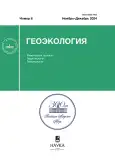Рrobabilistic-statistical assessment of karst and suffosion hazard and risk of destruction by sinkholes of the main facilities at the Nizhny Novgorod NPP
- 作者: Anikeev A.V.1
-
隶属关系:
- Sergeev Institute of Environmental Geoscience of the Russian Academy of Sciences
- 期: 编号 6 (2024)
- 页面: 15-24
- 栏目: NATURAL AND TECHNONATURAL PROCESSES
- URL: https://journal-vniispk.ru/0869-7809/article/view/288795
- DOI: https://doi.org/10.31857/S0869780924060028
- EDN: https://elibrary.ru/AMFFCK
- ID: 288795
如何引用文章
详细
In the mathematical description of sinkhole distribution with time, sinkholes are considered as random discrete events. The diameter of funnels is the main indicator of sinkhole impact power on the environment, and the intensity of sinkhole occurrence is the main probabilistic index. Most generally, the risk of losses from karst-suffosion sinkholes is the product of subsidence probability by the damage caused by a recipient object deformation or destruction. Formulas of direct damage and vulnerability have been derived, allowing for a unified assessment of physical and economic losses from damage to engineering and territorial facilities caused by geological processes. Two currently used stochastic models of sinkhole formation in covered karst areas are considered, i.e. exponential and linear models. It is shown that with the intensity of the process and the area of risk recipients less than 0.1 year–1⋅km–2 and 10 ha, respectively, these models give close values of the probability of damage to recipient objects. The linear model, written as a system of two equations, is devoid of some of its disadvantages and allows one to predict the risk of losses in case of non-compliance with Poisson’s law. In the article, the assessment of the risk of radioactive emissions and out-of-design accidents at the site of the projected NNPP power units is based on data obtained during surveys on 14 sinkholes formed over 53 years in an area of 50 km2, in the center of which the industrial site is located. The Poisson flow of events is found to take no place in this area, and a linear risk model has been chosen for the forecast, written as the product of the frequency of sinkholes occurrence under the four main structures of the NNPP by their vulnerability. Taking into account some assumptions and design features of engineering facilities, it is shown that the risk of their beyond-design accidents and the risk of radiation emissions at the industrial site are many times less than their permissible values specified by regulatory documents on the use of atomic energy in Russian Federation.
全文:
作者简介
A. Anikeev
Sergeev Institute of Environmental Geoscience of the Russian Academy of Sciences
编辑信件的主要联系方式.
Email: anikeev_alex@mail.ru
俄罗斯联邦, Bldg. 2, 13, Ulansky Lane, Moscow, 101000
参考
- Anikeev, A.V. [Sinkhole hazard and risk of its formation in karst areas: main indices, approaches and methods of evaluation]. Inzhenernaya geologiya, 2016, no. 5, pp. 10−18 (in Russian)
- Anikeev, A.V. [Collapse and subsidence sinkholes in karst areas: mechanisms of formation, forecast and risk assessment]. Moscow, RUDN Publ., 2017, 328 p. (in Russian)
- Viktorov, A.S. [The main problems of mathematical morphology of the landscape]. Moscow, Nauka Publ., 2006. 252 p. (in Russian)
- Glinskii, M.L., Egorova, V.A., Chertkov, L.G. [Geological structure specifics at the location of the Nizhni Novgorod NPP and their consideration in the design solutions for its construction]. Razvedka i okhrana nedr, 2012, no.10, pp. 49−52. (in Russian)
- [Karstology. Part 3. Engineering karstology: a textbook]. V.N. Dublyanskii, G.N. Dublyanskaya, V.N. Kataev, et. al. Perm, Perm State National University, 2011, 288 p. (in Russian)
- Kataev, V.N., Shcherbakov, S.V., Zolotarev, D.R., Drobinina, E.V. [Karst hazard assessment in chalk deposits on the example of Vyshkov settlement, Bryansk oblast]. Inzhenernaya geologiya, 2022, vol. XVII, no. 3, pp. 44–63. (in Russian)
- Malugin, V.A. [Probability theory and mathematical statistics: textbook and workshop for secondary professional education]. Moscow, Yurait Publ., 2024, 470 p. (in Russian)
- [Natural hazards in Russia. Assessment and management of natural risks. Thematic volume]. A.L. Ragozin, Ed., Moscow, KRUK Publ., 2003, 320 p. (in Russian)
- Ragozin, A.L. [Current state and prospects of assessment and management of natural risks for construction]. In: [Analysis and assessment of natural and human-induced risk for construction]. Moscow, PNIIIS, 1995, pp. 9–25. (in Russian)
- Ragozin, A.L., Yolkin, V.A. [Regional assessment of karst hazard and risk]. Problemy bezopasnosti i chrezvychainykh situatsii. 2003, no. 4, pp. 33–52. (in Russian)
- [Recommendations for the assessment of geological risk in the territory of Moscow]. A.L. Ragozin, Ed. Moscow, GUP NIATs Publ., 2002, 59 p. (in Russian)
- [Recommendations for engineering survey, design, construction and the operation of buildings and engineering structures in karst-prone areas of the Nizhny Novgorod region]. Nizhny Novgorod, 2012, 140 p. (in Russian)
- Savarenskii, I.A. [The forecast of territory stability by the method of remoteness from the nearest karst manifestation]. In: [Forecast of changes in engineering and geological conditions upon construction]. Moscow, Nauka Publ., 1990. pp. 108–118. (in Russian)
- Savarenskii, I.A., Mironov, N.A. [Guidelines for engineering and geological surveys in karst development areas]. Moscow, PNIIIS, Gosstroi of Russia, 1995, 167 p. (in Russian)
- Tolmachev, V.V. [A probabilistic approach to assessing the sustainability of karst areas and designing karst-control measures]. Inzhenernaya geologiya, 1980, no. 3, pp. 98–107. (in Russian)
- TSN 11-301-2004Po. [Regional construction standards 11-301-2004Po. Engineering geological survey for construction in the territory of Perm region]. Perm, 2004, 122 p. (in Russian)
- TSN 22-308-98 NN. [Regional construction standards 22-308-98 NN. Engineering survey, design, construction and the operation of buildings and engineering structures in karst-prone areas of the Nizhny Novgorod region]. 1999. 72 p. (in Russian)
- Khomenko, V.P. [Karst sinkhole formation: mechanism and hazard assessment]. In: [Environmental safety and construction in karst areas. Proc. Int. Symp.]. V.N. Kataev et al., Eds., Perm, Perm State University, 2015, pp. 50−60. (in Russian)
- Birkmann, J. Risk. In: Encyclopedia of natural hazards. P.T. Bobrowsky, Ed., Springer, 2013, pp. 856−862.
- Kalsnes, B., Nadim, F., Lacasse, S. Managing geological risk. In: Geologically active. A.L. Williams, G.M. Pinches, C.Y. Chin et al., Eds. London, CRC Press, 2010, pp. 111–126.
补充文件














